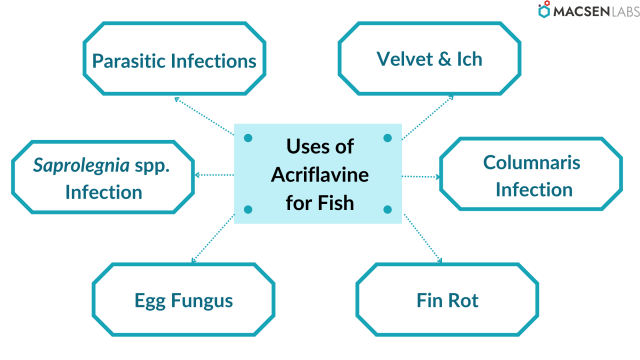Home » Blog » Acriflavine » Acriflavine for fish
Acriflavine is a treatment and a preventative for Oodinium or better known as Velvet infection in marine fish as well as freshwater fish. It’s also used for the treatment of aquarium fish that have external fungal infections.
Table of Contents
Acriflavine for the Treatment of Fish
Acriflavine has a history of being used in the treatment and prevention of the diseases of fish. Acriflavine is used for the disinfection of fish eggs, treatment of open wounds, and treatment of external protozoan infections. This chemical has been said to be very effective when it comes to the treatment of columnaris bacterial infection, better known as Flexibacter columnaris. Although, it is not mainly used for the treatment of other bacterial infections. It is known that some fish species are quite sensitive to Malachite Green. Acriflavine can be used instead of malachite green.
Acriflavine is an antiseptic compound from topical agents. Acriflavine is a brownish-orange powder. It protects ornamental fish from external parasitic infections in both marine environments and freshwater. Acriflavine works as a fungicide against Cryptocaryon irritans, Hexamita, Ichthyophthirius multifiliis, Saproglenia sp. Ambiphyra, Chilodonella, Oodinium, and Schyphidia species are quite resistant to it as a protozoacide. It is also used to cure external fungal infections in a fish aquarium.
When to use
Acriflavine can be used when you encounter certain issues in your fish tank; they are mentioned below:
- Preventing fungus growth and Disinfecting fish eggs.
- Effective in the treatment of Oodinium pilularis or known as Velvet disease.
- Cottonmouth bacteria are reduced by using Acriflavine.
- Treatment of fungal infections in freshwater fish.
- To stop infection, one can use it on open wounds or sores.
Ruby Reef Rally is the only product available in the market that has Acriflavine. It also has a small amount of aminoacridine and formalin. It is used for a ninety-minute bath, with water temperature being controlled and a lot of aeration is provided by the air pump and air-stone.
How to use (Dosage)
Put 200 mg of Acriflavine per ten gallons or 5ppm of stock holding tank water or aquarium water for a long bath of usually 3 to 5 days. You don’t need to change the water. If it is used in a planted aquarium, it can kill the plants and have a bad effect on the good nitrogen-reducing bacteria in the filtration system of your tank.
Make a ten ppm treatment bath in another treatment container with aeration for a short bath that is usually for 2 hours. Make sure that ten ppm = 10 mg Acriflavine per litre of the treatment of water or 37.8 mg per gallon of treated water. Put the fish back to the habitat water after 2 hours of treatment.
Uses of acriflavine for fish

Parasitic diseases
It is used in the aquarium to cure various ailments, that includes bacterial and fungal infections, along with disinfecting open wounds in fish. It is also used to disinfect fish eggs, which helps to stop fungus infection. Acriflavine can also be used as a substitute for Malachite Green when it comes to the treatment of disease in scale-less fish like elephant-nose, catfish, and some Characin species.
Velvet
This condition is caused by Oödinium pillularis or Oödinium limneticum in freshwater fish. Amyloödinium ocellatum causes the disease known as Coral Fish Disease in fish. The life cycles and symptoms of all 3 species are almost similar to those of the popular parasite Ich. Velvet is very infectious and mainly appears when aquarium conditions are very bad. New fish should be kept quarantined for 2 weeks to limit the risk of contamination in a fish tank.
Flavobacterium columnar
Columnaris is a bacterial infection that can occur on the inside or the outside of the body and can be chronic and acute in its nature. It has mould-like lesions that make the columnaris bacteria or Flavobacterium columnare to be misunderstood as a fungal infection. Although, the treatment can be made with antibiotics and prevented with the right tank maintenance. Antibiotics, chemicals in the water, or both need to be used to treat external infections. To treat columnaris, acriflavine can be used in the water.
Fin Rot
Fin rot is the most common disease in aquarium fish, but it’s also the easiest to avoid. Fin rot can be caused by different bacteria species, but the main cause is always environmental and is mainly linked to stress. Fish are more prone to fin rot when they are overcrowded, moved, or paired with aggressive fish.
Egg Fungus
Acriflavine is mainly used as a topical antiseptic, and it is combined with proflavine in commercial formulations. It helps in the treatment of everything from fungal infections in fish to treating and disinfecting open wounds in the fish tank. Acriflavine is used to disinfect fish eggs also, which helps to prevent fungus infection, known as egg fungus.
Saprolegnia spp
Acriflavine treats fungus Saprolegnia spp and Fin and Tail Rot infections in freshwater aquariums. It also helps in the prevention of fungus growth on fish eggs before hatching.
Ich
Plants and marine invertebrates aren’t safe when Acriflavine is used for the treatment of Ich. To start, make sure that the water has a pH of 7.0 or more. Its efficacy is maintained because of this. Then, to avoid removing the Acriflavine from the water, take out any carbon from the filtration system.
Thus, Acriflavine can be used for the treatment of a wide range of infections.
Side Effects
Using acriflavine for fish may have these side effects:-
- Turns the water to an orange-brownish colour, making it unsuitable for use in a quarantine or display tank.
- At a high dosage, acriflavine can be stressful for many fishes.
- It is also believed to cause infertility in fishes.
At this moment, the full range of good effects and potential adverse effects is not fully understood.
FAQs
Q. How to use acriflavine for fish?
Acriflavine can be used as a short term (5 minutes to 1 hour) or long term bath (3 days to 3 weeks) for fish or it can be added to the aquarium water to treat the entire tank. Topical application is sometimes used on wounds to help prevent bacterial infection.
Q. What does acriflavine treat?
Acriflavine is used to treat a variety of ailments in fish like bacterial and fungal infections and in disinfecting open wounds. It is also used to disinfect fish eggs, thereby preventing the loss of eggs to fungus.
Q. Is acriflavine safe for fish?
Acriflavine can be used as a short term bucket dip for fish, or it can be added to the aquarium water to treat the entire tank, preventing higher dosage as it may be stressful for many fish. Also, it severely damages live plants and stains artificial plants and other decorations in the tank.
Q. How long does acriflavine stays in pond water?
Mix the appropriate dosage in a clean bucket of pond water, pour evenly over the surface of the pond and leave for 7 days for effective results.
Macsen Labs is a manufacturer and supplier of several grades of Acriflavine such as:-
Acriflavinium Chloride EP-5.0 (Ph Eur)
For buying Acriflavine, send us an enquiry-
Disclaimer-
The information provided here is based on general knowledge, articles, research publications etc and we do not claim the authenticity of any of the information provided above. We do not claim or suggest/advise any medical, therapeutic, health or nutritional benefits of Acriflavine. We do not supply or promote our Acriflavine product for the applications which are covered by valid patents and which are not approved by the FDA.



